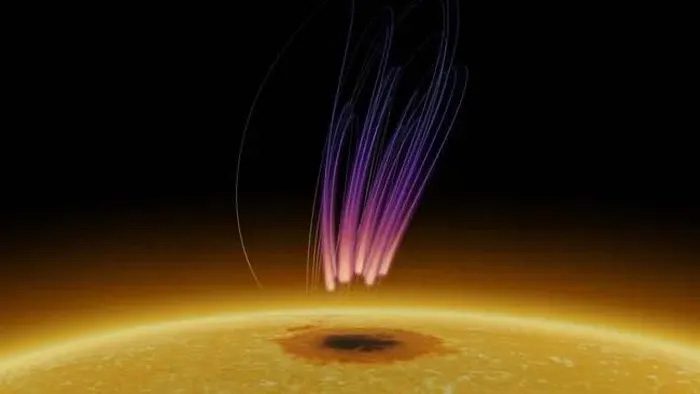Scientists Discover Aurora-like Radio Signals from Sunspots
Researchers have detected radio waves crackling “like auroras” on the surface of the Sun, resembling the auroras on Earth.
The solar light display occurred approximately 40,000 km from a sunspot, a magnetically distorted dark area on the Sun’s surface. Astronomers on Earth have been observing these bursts of radio waves for a week.

Illustration of aurora-like emissions from the Sun’s surface. (Photo: Sijie Yu)
Previously, scientists have detected aurora-like radio signals from distant stars, but this is the first time they have observed such signals from the Sun. They published their findings on November 13 in the journal Nature Astronomy.
Sijie Yu, an astronomer at the New Jersey Institute of Technology’s Center for Solar-Terrestrial Research (NJIT-CSTR), stated: “This is completely different from fleeting solar radio bursts, which typically last for minutes or hours. This is an exciting discovery that has the potential to change our understanding of stellar magnetic processes.”
On Earth, auroras are the result of solar energetic particles colliding with the atmosphere near the poles, where the magnetic field is weakest, exciting oxygen and nitrogen molecules. This causes the molecules to release energy in the form of light, creating colorful rippling bands in the sky.
Solar energetic particles are often ejected from the Sun when the magnetic field around sunspots tightens into twisted lines before erupting dramatically. This energy release results in radiation bursts known as solar flares and jets of solar material referred to as coronal mass ejections.
By directing a radio telescope at a sunspot on the Sun’s surface, researchers discovered aurora-like emissions. They believe this is due to electrons from solar flares being accelerated along the strong magnetic field lines of the sunspot.
Yu added: “However, unlike auroras on Earth, these solar sunspot auroras occur at frequencies ranging from hundreds of thousands of kHz [kilohertz] to about 1 million kHz – a direct result of the sunspot’s magnetic field being thousands of times stronger than Earth’s magnetic field.”
The researchers noted that their discovery has opened new avenues for studying solar activity. They have begun examining archived data to uncover hidden evidence of past auroras.
Co-author Surajit Mondal, a solar physicist at NJIT, remarked: “We are beginning to unravel how magnetic fields and energetic particles interact within a system that has long-lasting stellar points. Not only with the Sun, but we will also continue to explore stars beyond our solar system.”




















































